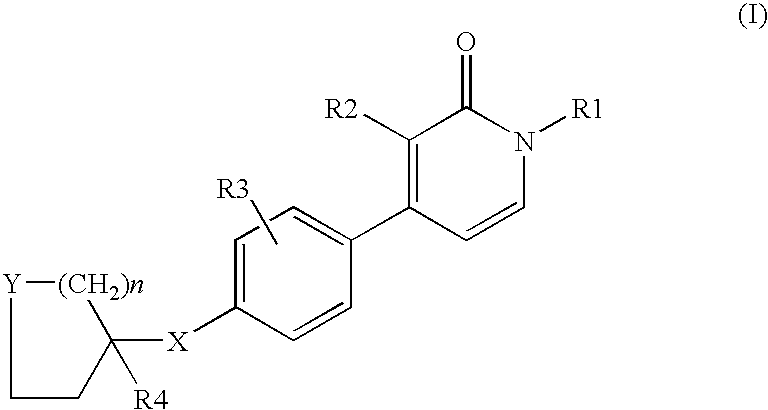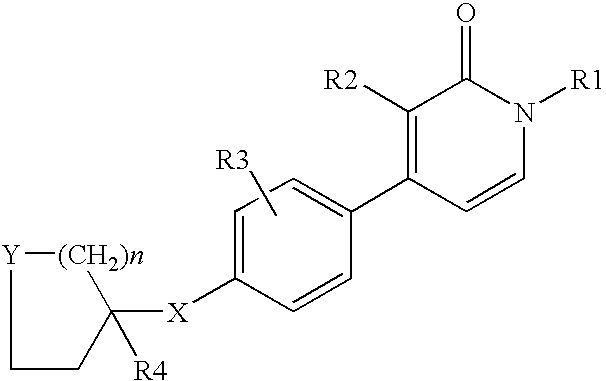1,3-disubstituted-4-phenyl-1h-pyridin-2-ones
a technology of pyridinone and disubstituted phenyl-1h, which is applied in the field of new drugs, can solve problems such as glutamatergic neurotransmission imbalan
- Summary
- Abstract
- Description
- Claims
- Application Information
AI Technical Summary
Benefits of technology
Problems solved by technology
Method used
Image
Examples
example 1
3-Chloro-1-(3-methylbutyl)-4-[4-(tetrahydropyran-4-ylamino)-phenyl]-1H-pyridin-2-one (E1)
[0129]
A solution of intermediate D8 (0.65 g, 1.91 mmol) and N-chlorosuccinimide (0.25 g, 1.91 mmol) in DMF (10 ml) was stirred at 45° C. for 16 hours. After cooling to room temperature water was added and the solution was extracted with EtOAc, The organic layer was separated and washed with brine, dried (Na2SO4) and the solvent evaporated in vacuo. The crude product was purified by column chromatography (silica gel; DCM / EtOAc 8:2 as eluent). The desired fractions were collected and evaporated in vacuo to yield E1 (0.20 g, 28%) as a pale pink solid.
[0130]Melting point: >300° C.
example 2
1-Butyl-3-chloro-4-{4-[4-(tetrahydropyran-2-yloxymethyl)-tetrahydropyran-4-yl]-phenyl}-1H-pyridin-2-one (E2)
[0131]
A mixture of intermediate D6 (0.17 g, 0.5 mmol), intermediate D12 (0.2 g, 0.5 mmol), catalyst tetrakis(triphenylphosphine)palladium(0) (0.03 g, 0.025 mmol) and NaHCO3 (3 g, excess) in dioxane (6 ml) was heated at 150° C. for 10 minutes under microwave irradiation. After cooling to room temperature the reaction mixture was filtered through diatomaceous earth, treated with EtOAc and the organic layer was washed with water and then with brine. The organic fraction was dried (Na2SO4) and the solvent evaporated in vacuo. The crude residue was purified by column chromatography (silica gel; 0-10% EtOAc / DCM as eluent). The desired fractions were collected and evaporated in vacuo to yield E2 (0.10 g, 45%) as a colorless oil.
example 3
1-Butyl-3-chloro-4-[4-(4-hydroxymethyl-tetrahydropyran-4-yl)-phenyl]-1H-pyridin-2-one (E3)
[0132]
A mixture of compound E2 (0.10 g, 0.22 mmol) and a catalytic amount of p-toluenesulfonic acid in methanol (10 ml) was stirred at room temperature for 1 hour. The solvent was evaporated in vacuo and the resulting residue was taken up with DCM, washed with an aqueous saturated solution of NaHCO3, the combined organic extracts were dried (Na2SO4) and the solvent was evaporated in vacuo. The crude residue was purified by column chromatography (silica gel; 0-30% EtOAc / DCM as eluent). The desired fractions were collected and evaporated in vacuo to yield E3 (0.05 g, 61%) as a colourless oil.
[0133]Compounds E4 to E9 (Table 1) were prepared in a similar manner.
Physico-Chemical Data
LCMS—General Procedure
[0134]The HPLC measurement was performed using a HP 1100 from Agilent Technologies comprising a pump (quaternary or binary) with degasser, an autosampler, a column oven, a diode-array detector (DAD)...
PUM
| Property | Measurement | Unit |
|---|---|---|
| temperature | aaaaa | aaaaa |
| temperature | aaaaa | aaaaa |
| temperature | aaaaa | aaaaa |
Abstract
Description
Claims
Application Information
 Login to View More
Login to View More - R&D
- Intellectual Property
- Life Sciences
- Materials
- Tech Scout
- Unparalleled Data Quality
- Higher Quality Content
- 60% Fewer Hallucinations
Browse by: Latest US Patents, China's latest patents, Technical Efficacy Thesaurus, Application Domain, Technology Topic, Popular Technical Reports.
© 2025 PatSnap. All rights reserved.Legal|Privacy policy|Modern Slavery Act Transparency Statement|Sitemap|About US| Contact US: help@patsnap.com



